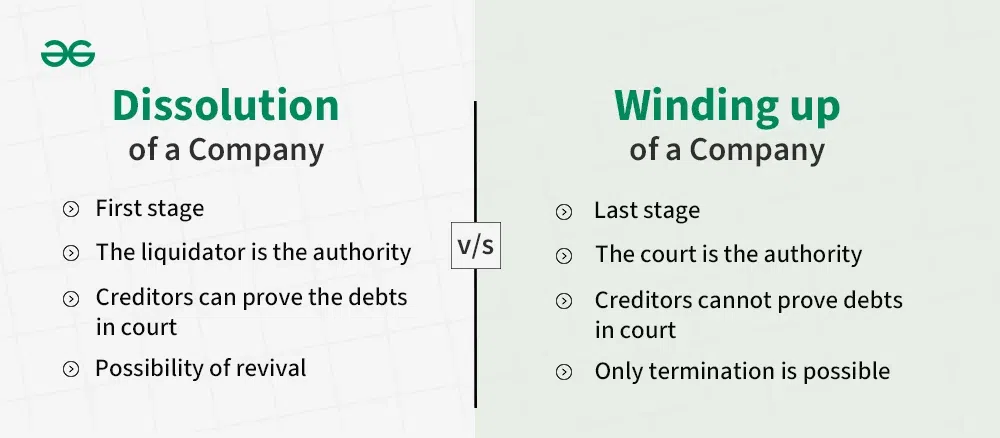Difference between Dissolution and Winding up of a Company
Last Updated :
13 Feb, 2024
Dissolution of a company is a legal process where a company is dissolved by an order of a Tribunal; i.e., National Company Law Tribunal (NCLT), after the winding up process is completed. Dissolution brings a company’s existence to an end, and the name is struck off by the Registrar of Companies (ROC). Both Dissolution and Winding up are related to the company’s end and are mostly confused. The process of winding up is the one where the liquidator is appointed to settle and distribute the company’s assets among the creditors and other relevant stakeholders. Only when the winding-up process is completed does dissolution take place.

What is Dissolution of a Company?
Dissolution is a legal process that terminates the existence of a company. The name of the company is struck off from the Registrar of Companies, and it shall be published in the official gazette. Dissolution of a company can be done in the following two ways:
- By transferring the company’s undertaking to another company under a scheme of amalgamation or reconstruction. The order of NCLT will dissolve the company without being wound up.
- After settling the debts of the company, the remaining amounts will be distributed to the stakeholders and the NCLT will pass an order for dissolution.
What is Winding up of a Company?
Winding up is a process of bringing a company’s affairs to a close, liquidating its assets, and distributing the proceeds among its creditors and shareholders. A liquidator is appointed to take control of the company and realises the company’s assets, and applies the proceeds in payment of its debts.
Winding up can be voluntary or compulsory. The compulsory winding up process is done when the creditors, the ROC, or the company itself apply for winding up to the NCLT. On the other hand, voluntary winding up is initiated when the company applies to NCLT to initiate the winding up process after passing a special resolution.
Difference between Dissolution and Winding up of a Company
|
Basis
|
Dissolution
|
Winding up
|
|
Meaning
|
Dissolution is a legal process that terminates the existence of a company. The name of the company is struck off from the Register of Companies, and it is published in the official gazette. |
Winding up is a process of bringing a company’s affairs to a close, liquidating its assets, and distributing the proceeds among its creditors and shareholders. |
|
Process
|
It is the end process of winding up and getting the name struck off from the Register of Companies. |
It is one of the methods through which the dissolution of a company is carried on. |
|
Existence of a Company
|
Dissolution brings an end to the legal entity status of a company. |
The company’s legal entity continues and exists at the commencement and during the winding up process. |
|
Continuation of Business
|
The company ceases to exist once it is dissolved. |
During winding up, a company can be allowed to continue its business if it is required for the beneficial winding up of the company. |
|
Moderator
|
The order for Dissolution is passed by NCLT. |
The process of Winding up is carried out by the liquidator. |
|
Activities Included
|
Filing resolutions, declarations, and other documents required by the NCLT to pass the dissolution order. |
Filing of winding up resolution, appointment of liquidator, disclosures to ROC, and filing for resolution to the NCLT. |
Conclusion
In conclusion, Dissolution and Winding up are two legal processes that are used to bring a company’s affair to an end. Winding up is a process of liquidating a company’s assets, whereas dissolution is the final stage that terminates the company’s legal existence. Both processes are equally important for ensuring that a company’s affairs are resolved in an orderly and smooth manner for releasing the shareholders and directors from their ongoing legal and financial obligations.
Frequently Asked Questions (FAQs)
1. What is Winding up, and how is it different from Dissolution?
Answer:
Winding up is the process of bringing a company’s affairs to an end, whereas Dissolution is the legal process of terminating the company’s existence. In short, winding up is the process that precedes dissolution.
2. Who is responsible for initiating the winding up process?
Answer:
The process of winding up can be initiated by the company’s directors, shareholders, or by an order of the court.
3. What happens to the company’s officers and directors during the winding up process?
Answer:
They remain in place during the winding up process and have a legal duty to act in the best interest of a company.
4. What happens to the company’s shareholders during the winding up process?
Answer:
They may receive distributions of the proceeds from the sale of the company’s assets after all of the company’s outstanding debts and liabilities have been paid off.
5. What happens to the company’s legal obligations after it has been dissolved?
Answer:
Once dissolved, the company won’t be able to enter into legal contracts, but it may still be liable for any outstanding legal or financial obligations that existed before its dissolution.
Share your thoughts in the comments
Please Login to comment...